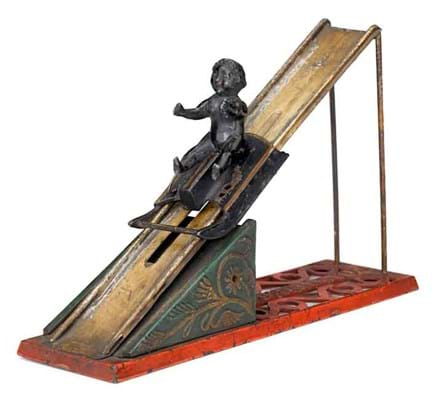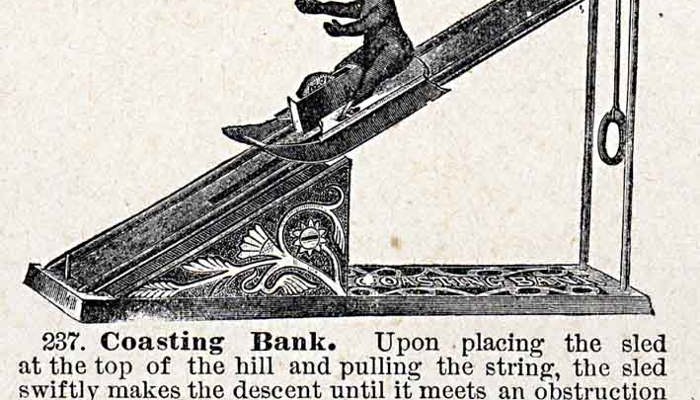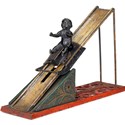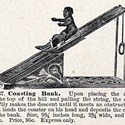It was back in 1955 that a dealer in Americana, rummaging in a second-hand shop in upstate New York, happened upon an advertisement in Ehrich's Fashion Quarterly dated 1884. A previously unrecorded 'baby on a sled' novelty bank was pictured alongside the title Coasting Bank, the price of 95 cents and the description: Upon placing the sled at the top of the hill and pulling the string, the sled swiftly makes a descent until it meets an obstruction that lands the coaster on his head and deposits the coin in the bank.
An article was promptly written for the April 1955 issue of Hobbies Magazine that concluded "this bank is not known to be in any collection and the catalogue offers us our first information about it".
Discussions and conjecture regarding the existence or otherwise of the Coasting Bank have continued since, but events took a turn earlier this year when a lady, clearing out her mother-in-law's attic in Peebles, Scotland, took an enigmatic find to the Antiques Roadshow. There the Coasting Bank (it was titled to the cast-iron slide) was seen by miscellaneous expert and managing director of Bonhams Knightsbridge, Jon Baddeley, who hailed its discovery and suggested it might be a very valuable find.
Roadshow Contract
Of course, valuation on the Roadshow can be a double-edged sword if you are one of the specialists like Mr Baddeley. The glow of publicity is always welcome but - as contracted by the BBC - the expert is not allowed to sell the discovery on the owner's behalf. Keen to sell, the owner, when pointed in the direction of other Edinburgh auction houses as alternatives, plumped for Lyon & Turnbull.
It was not a bad decision given L&T's transatlantic marketing alliance with Freeman's of Philadelphia. Freeman's unveiled it, with much fanfare, at the Mechanical Bank Collectors of America annual banquet on September 28. And collectors loved it.
The history of the bank still merited research. Although there is no patent information available for the Coasting Bank, certain features warrant an attribution to the illustrious bank designer Charles A. Bailey. Working for J. & E. Stevens Company from the 1880s to about 1915 when he established himself as an independent designer and manufacturer, he was responsible for many great mechanical banks, including the rare Bismark Pig Bankand the Germania Exchange Bank, both featured alongside the Coasting Bank in the Ehrich's Fashion Quarterly advertisement.
Bailey had a penchant for utilising a lead-zinc alloy in his designs and the Coasting Bank's cast-lead figure, therefore, serves to reaffirm the attribution.
It's possible, given their similarities in terms of the action and the overall design, that the Coaster served as the predecessor to the Shoot the Chute mechanical bank designed by Charles A. Bailey for J. & E. Stevens and patented in 1906.
The Coasting Bank featured in Freeman's American Furniture, Folk & Decorative Arts auction on November 13 in Philadelphia. Quite what it was worth was anyone's guess but the sensible money was on a price somewhere midway between the estimate of $30,000-50,000 and the record for a cast bank (a price in excess of $400,000 paid during the zenith of the collecting boom). Bringing this remarkable tale to a conclusion, it sold at $220,000 (£143,790) to a US collector.
The full story will feature in a Christmas edition of the Antiques Roadshow.








